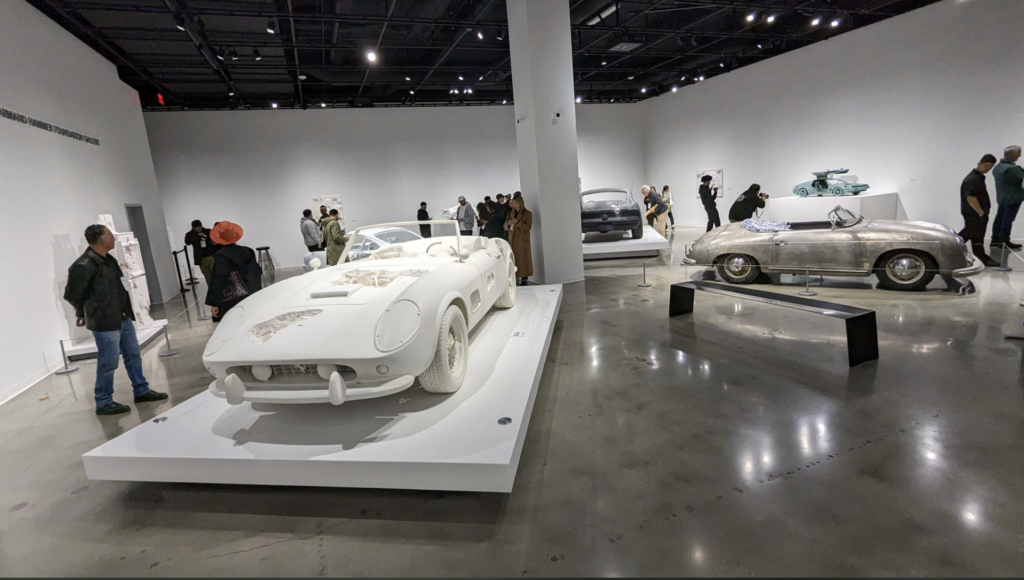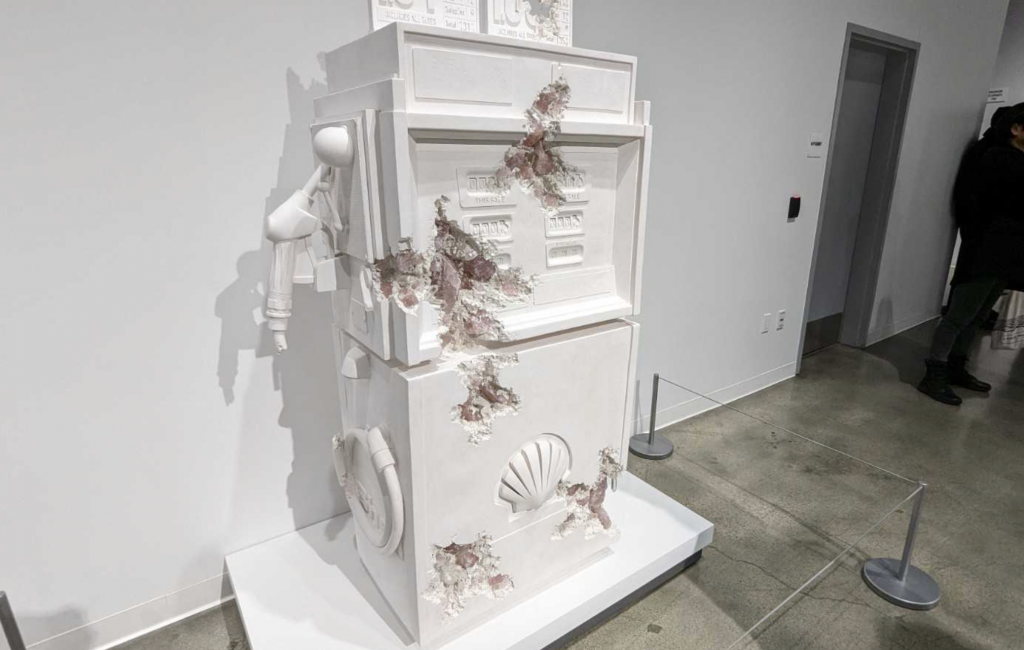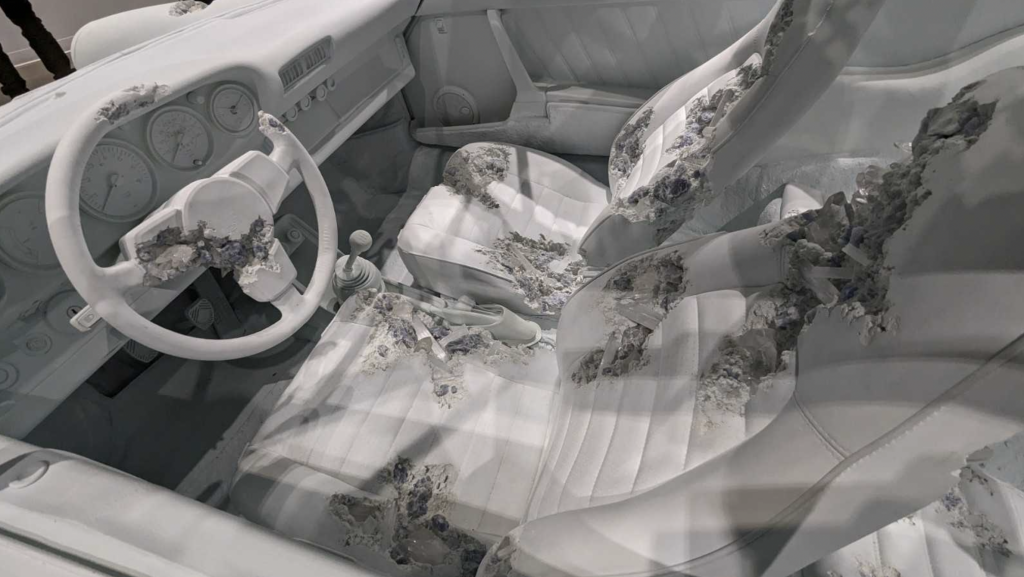I wasn’t really planning on attending artist Daniel Arsham’s exhibit “Arsham Auto Motive” at the Petersen Automotive Museum in downtown LA last week. I’d received the invite, but wasn’t sure since I admittedly wasn’t familiar with Arsham’s work. Then a friend asked if I’d like to join, so I said “sure.” What I saw was surprisingly moving.
I was primarily at the event to look at The Petersen’s collection, talk about cars, and hang out with friends, but upon watching a fireside chat with Miami-raised 42 year-old artist Daniel Arsham (whom you can learn more about here), one thing became clear: He’s a legitimate car enthusiast. Someone’s car-enthusiasm credentials can be hard to assess, and I’ve found that even the vehicles someone owns aren’t always a great indicator (though I should note that Arsham’s first car was a Saab 900T; he’s a big Porsche guy these days, and owns an old Safari 911). It was the way Arsham spoke about cars that convinced me he’s the real deal; there was so much depth, so much emotion, so much substance in the way he discussed what cars mean to him and to the world at large.

Arsham talked about how cars fit into a zeitgeist, and how they have the capability to provide a palpable representation of an entire era in society. Here’s what he told Wallpaper about his exhibit “Turning Wrenches” at Detroit’s Library Street Collective:
I’ve had a fascination with cars in general since I was a kid. Cars, to me, have always had an ability to create a sense of time travel. You can get into a perfectly restored car from the 1970s or 1990s, and there’s a very visceral sense of what it felt like to drive in those eras.
At The Petersen, Arsham spoke about the value of cars as a social glue — as a great equalizer that has the power to bring folks together. It’s something I’ve been saying for years, and it was just cool to hear him talk about that element of car culture in front of that audience.




Anyway, in time, someone grabbed a pair of giant scissors (likely ones sitting next to golden groundbreaking shovels and other oddly-specific groundbreaking tools), and snipped a red ribbon to allow my friends and me into the exhibit. I was in a rush, as I had another event to attend, so I only saw the display for a few minutes, but even this was enough to make me feel things.


What you’re seeing here is volcanic ash, pyrite, white quartz, and selenite crystals embedded in a casting that Arsham made out of plaster. You can get a glimpse of how Arsham does this in this HYPEBEAST YouTube video showing his DeLorean DMC-12 project:
As the press release for the exhibit calls it, what you’re seeing is Arsham’s “signature ‘eroded’ fictional archeological technique.” Here’s how The Petersen describes Arsham’s process:
Arsham’s “eroded” works occupy a space where the concepts of yesterday, today, and tomorrow collide, representing a fictional archaeology wherein objects from our cultural and material present are unearthed at some point in the distant future. These casts of modern artifacts are created from geological materials such as sand, quartz, and selenite, appearing fossilized as if they have just been discovered after being buried for ages. Through the sculptures displayed in Arsham Auto Motive, the artist historicizes the automobile—a paragon of the modern era—and its related symbols, presenting the viewer with a glimpse of future history.
Arsham told the audience at the fireside chat that he uses geological material because it “has this age to it that feels sort of impossible.” He says the crystals in the molds give off a vibe of decay, but also growth. I agree.

I know some of you more familiar with my wrenching articles are thinking 1. DT, you’ve gone Hollywood, attending art exhibits and contemplating buying an electric car and 2. It’s just some crystals; I don’t get it. But 1. You shouldn’t worry about me going Hollywood, because I’ve got some serious wrenching goodness that I’m excited to show you. And 2. It IS just crystals. And I didn’t really get it either, but then I saw it, and it made me feel something that I wasn’t expecting.



As someone who romanticizes cars and sees them as almost “living” things, I saw a darkness in Arsham’s cars. There’s a feeling, not just of decay, but of rot — of an infection. If there had just been chunks of the cars missing, that’d be one thing; but the fact that there are crystals seemingly growing in the voids makes it seem like an eerie growth is taking over the space that once was a beautiful automobile.

There’s a chasmic depth to these sculptures that gives off an almost dystopian feel. The interior shot at the top of the article, in particular, got me good. Here’s another look:

Anyway, just thought I’d share that with you. The exhibit will be at The Petersen until November, 26.




The car nerd part of me is saying “but that’s not what cars look like under the skin! There should be seat springs poking out, and mechanical components, etc.”
However, the rest of me appreciates this as some really nice art with an automotive theme to it. I’ll listen to that part of me.
My initial thought of the top pic was that the car had a terrible mold problem.
These just make me feel itchy.